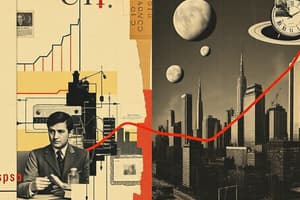Podcast
Questions and Answers
What is the primary focus of endogenous growth theory in explaining growth rates?
What is the primary focus of endogenous growth theory in explaining growth rates?
- Geographical and environmental factors
- Government policies and regulations
- Societal decisions, particularly saving rates (correct)
- Cultural and historical backgrounds
What is a key characteristic of investment in knowledge capital, according to endogenous growth theory?
What is a key characteristic of investment in knowledge capital, according to endogenous growth theory?
- No marginal returns
- Increasing marginal returns (correct)
- Diminishing marginal returns
- Constant marginal returns
What is the observed trend in income levels between poor and rich countries?
What is the observed trend in income levels between poor and rich countries?
- Divergence, with poor countries becoming poorer
- Convergence, but at a very slow rate (correct)
- No change, with a persistent income gap
- Convergence, at a rapid rate
What is the relationship between higher saving rates and equilibrium growth rates, according to endogenous growth theory?
What is the relationship between higher saving rates and equilibrium growth rates, according to endogenous growth theory?
What is the author's tone in the opening quote of Box 4-1?
What is the author's tone in the opening quote of Box 4-1?
What is the significance of the 19-year period mentioned in the text?
What is the significance of the 19-year period mentioned in the text?
What is the average annual growth rate of GDP per capita in India from 1988 to 2007?
What is the average annual growth rate of GDP per capita in India from 1988 to 2007?
Which of the following countries has the highest average annual growth rate of GDP per capita from 1970 to 2007?
Which of the following countries has the highest average annual growth rate of GDP per capita from 1970 to 2007?
What is the main difference between the production function in the neoclassical theory and the endogenous growth model?
What is the main difference between the production function in the neoclassical theory and the endogenous growth model?
What is the main reason why the economy eventually reaches a steady state in the Solow growth diagram?
What is the main reason why the economy eventually reaches a steady state in the Solow growth diagram?
What is the main purpose of modifying the production function in the endogenous growth model?
What is the main purpose of modifying the production function in the endogenous growth model?
What is the main difference between Figure 4-1 a and Figure 4-1 b?
What is the main difference between Figure 4-1 a and Figure 4-1 b?
Flashcards are hidden until you start studying
Study Notes
Growth and Policy
- Economic growth rates vary widely across countries and across time.
- Endogenous growth theory attempts to explain growth rates as functions of societal decisions, particularly saving rates.
- The role of human capital and investment in new knowledge is a key to endogenous growth theory.
Income Convergence
- Income in poor countries appears to be converging toward income levels of rich countries, but at extremely slow rates.
Endogenous Growth Theory
- Emphasizes different growth opportunities in physical capital and knowledge capital.
- There are diminishing marginal returns to physical capital, but perhaps not to knowledge capital.
- Increased investment in knowledge increases growth, linking higher saving rates to higher equilibrium growth rates.
Nobel Laureate's Words
- Robert E. Lucas, Jr. questions whether there is an action a government can take to lead to higher growth rates, and what it is about the "nature of India" that makes it difficult to achieve.
GDP Per Capita Growth
- Table 1 shows average annual growth rates of GDP per capita from 1970 to 2007 for various countries.
- India succeeded in dramatically increasing its growth rate from 1970 to 2007, joining the "fast-growth" club with China, Taiwan, and South Korea.
Mechanics of Endogenous Growth
- The solution to theoretical and empirical problems with neoclassical theory lies in modifying the production function to allow for self-sustaining—endogenous—growth.
- Endogenous growth theory differs from neoclassical theory in that it allows for constant marginal product of capital, leading to self-sustaining growth.
Studying That Suits You
Use AI to generate personalized quizzes and flashcards to suit your learning preferences.




